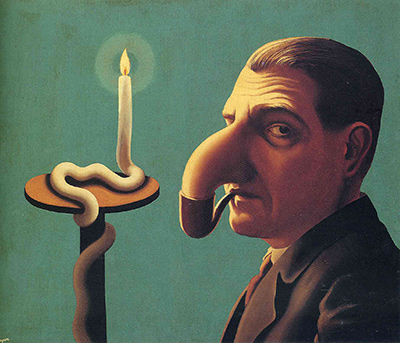Philosopher's Lamp is a surreal oil on canvas painting by artist René Magritte. Completed in 1936, the piece was thought provoking for the time and is still today.
The painting is a self-portrait. The man in the painting is looking towards the audience through rather sad looking eyes. He has a pipe in his mouth, and his nose is painted to be much bigger than his other features. His nose looks more like an elephant trunk. It is buried into the pipe he is smoking. There is a table next to him with a lit candle meandering down the table.
The painting allows the audience to know of Magritte’s awareness of his own feeling and addiction. By painting the man taking the tobacco in such a way, and by making him appear to be sad portrays the message of Magritte's awareness to his own addiction to pleasures (such as smoking a pipe). The way in which the candle is shaped adds to the dreamlike style and theme common in surrealist paintings.
In the case of Philosopher's Lamp, it could be argued that the light from the candle is a representation of Magritte's way of thinking. He wants to burn the light so that he can see. Unlike many other surrealists, Magritte does not want to live life in a dream. The candle is a representation that although sometimes life is not clear, one can try to at least see the imperfections clearly.
In this case, the imperfections are shown through the theme of addictions. This point is reinforced even more so by the man in the piece being Magritte himself. He is aware of his own flaws. However, the way he gazes at the viewer in a sideways glance could also be a way to show the feeling of sadness or guilt in his flaws. If he were to be looking straight on, for example, it would be as if he were accepting of them. The title of the piece also relates to his The Treachery of Images and opens great philosophical discussion when compared.




